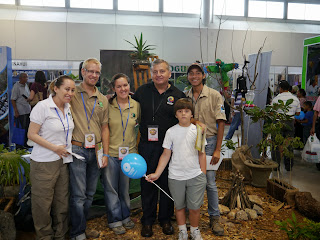Bosque Protector
Cerro Blanco hosted its Casa Abierta event on Saturday 19 October opening its doors and
sharing its many exciting projects and initiatives with the children,
students, families and groups of friends who visited to find out more about the
inner workings of Cerro Blanco and enjoy a day out in the beautiful
forest.
The purpose of the event was to provide an insight into the many conservation,
research, reforestation and tourism projects and activities at Cerro Blanco, which are not normally accessible to members of the public. Other local
organizations also attended and set up expositions - providing an overall
picture of the fantastic work going on in the various grassroots conservation
groups and communities of the Guayaquil area.
Some of Cerro Blanco's expositions included control and prevention of forest fires, protection and vigilance, research, the forest nursery and reforestation, environmental education and internships. Partner organizations taking part included the Fundacion Jambeli who operate an animal rescue and Papagayo breeding centre, The Nature Conservancy who are promoting the initiative for a wildlife corridor, the UPMA putting under the spotlight the grim reality of the illegal animal trade, and the Amigos del Estero who were promoting awareness of the importance of and threats to the Guayas estuary.
Bosque Protector
Cerro Blanco and its partners also presented in the bar area on a broad range
of topics, from illegal animal trafficking to butterfly research projects, offering expert views as well the opportunity
for group discussion.
There were
plenty of arts and crafts in action to. In celebration of the book Tangerine,
about the day in the life of a Grey Cheeked Parakeet who lives in New York,
there was an area set aside for coloring, cutting and gluing, as well
as a competition in which three lucky winners got copies of the book to take
home.
As part of
the event there was also a mini bat festival in honor of the AICOM award
received by Bosque Protector Cerro Blanco; bat lovers could spend time making
bat masks and other bat-related arts and crafts, and for those who wanted to
get up close and personal to our night-time friends there was also a special evening bat hunt to track down bats living in Cerro Blanco, and so learn more
about this fascinating animal and their important role in the forest ecosystem.
Within the beautiful
forest of Cerro Blanco, employees, friends and visitors had a fantastic day
out, learning more about the importance of the conservation, research, regeneration
and educational initiatives of Cerro Blanco and partner organizations, as well
as enjoying nature; be it by going on a short guided walk through the forest, a
cycle around the bike path or just by having a relaxing lunch under the trees.



























































